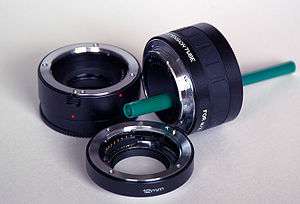Extension tube

An extension tube - also called extension ring - is used with interchangeable lenses to focus closer, useful in macro photography.[1]
Construction
The tube contains no optical elements; its sole purpose is to move the lens farther from the image plane. The farther away the lens is, the closer the focus, the greater the magnification, and also the greater the loss of light (requiring a longer exposure time). Lenses classically focus closer than infinity by moving all optical elements farther from the film or sensor; an extension tube simply enables this movement.
Extension tubes without electrical contacts will not allow an electronic automatic camera to control the lens, thus disabling autofocus and in some cases forcing a user to shoot wide open unless the lens offers manual aperture control. More expensive extension tubes contain electrical contacts allowing the user to use autofocus and electronically control the aperture of the attached lens. An advantage to the non-electrical tubes is their lower price.
Other items like lens adapters may unintentionally have an effect similar to an extension tube. A lens designed for a small flange focal distance may not be able to focus to infinity when a lens adapter places the sensor too far away.
Versus teleconverters
Extension tubes are sometimes confused with teleconverters, an optical component (i.e., containing lenses) designed to increase effective focal length.
References
External links
- DIY Extension Tube How to easily build your own extension tube.
- Canon EF 25mm Extension Tube II review at www.the-digital-picture.com
- "Close-up and Macro Photography" by Chuon-Szen Ong, Chapter "Extension tubes" at Nikonians.org
- Extension Tubes for Macro Photos at www.shutterfreaks.com
- Kenko Extension Tube Set review at www.the-digital-picture.com
- Experiments with Close-up Lenses and Extension Tubes